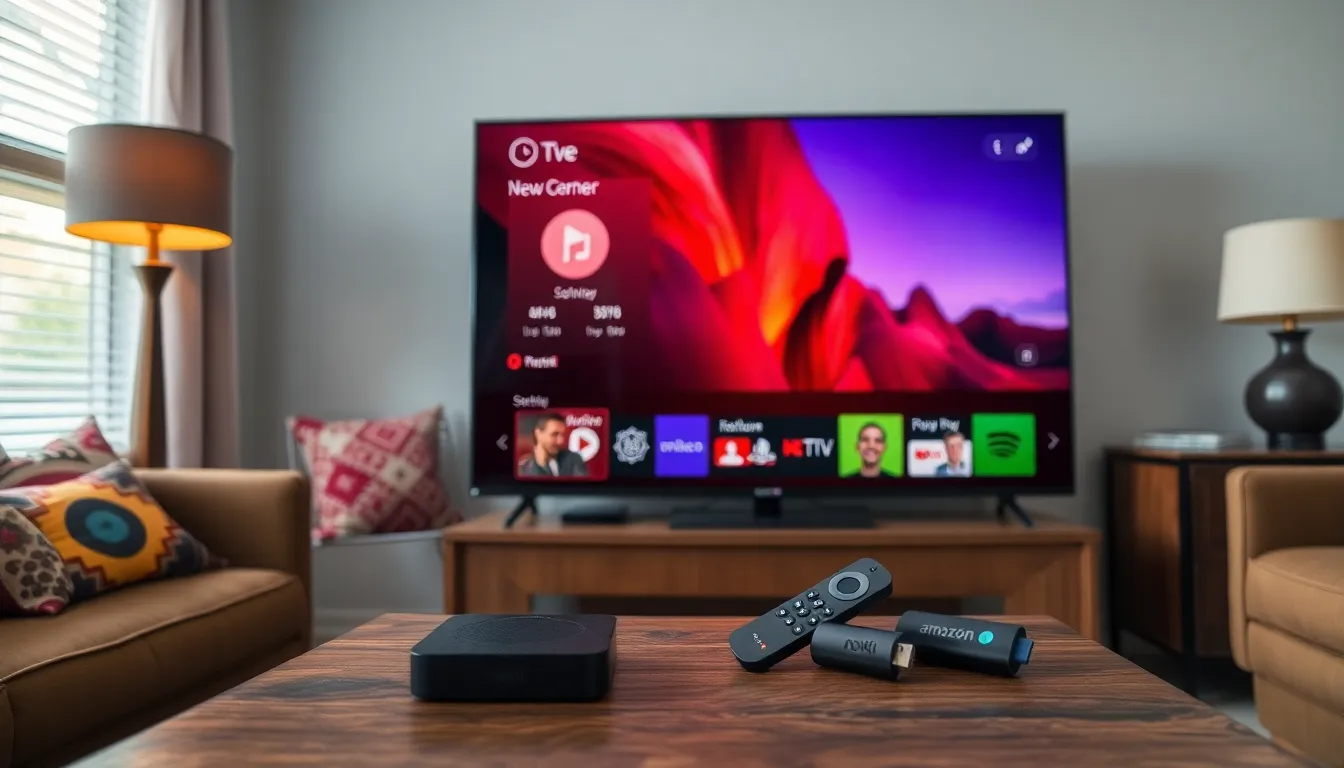In a world where binge-watching has become a competitive sport, streaming devices are the MVPs of home entertainment. Gone are the days of squinting at tiny screens or wrestling with tangled cords. Now, with a simple click, viewers can dive into a universe of movies, shows, and cat videos that can make anyone forget about their laundry pile.
These sleek gadgets not only turn any TV into a smart one but also provide access to a treasure trove of content. Whether it’s the latest blockbuster or that obscure documentary about the history of rubber ducks, streaming devices have got it covered. So grab your popcorn and settle in; it’s time to explore how these little wonders are revolutionizing the way we consume entertainment.
Table of Contents
ToggleOverview of Streaming Devices
Streaming devices facilitate the transition from traditional televisions to smart TVs, enhancing viewing experiences. Many consumers opt for devices such as Roku, Amazon Fire TV, and Apple TV, which provide diverse content options. These devices support popular streaming services like Netflix, Hulu, and Disney+, allowing seamless access to vast libraries of movies and shows.
Connection to the internet remains essential for streaming devices, as it enables content delivery without reliance on physical media. Physical design varies; some devices connect directly via HDMI, while others may resemble set-top boxes or even gaming consoles. Features such as voice control, user-friendly interfaces, and personalized recommendations enhance usability and engagement.
Low-cost options appeal to budget-conscious consumers, with devices available for under $50. Advanced features, including 4K streaming and Dolby Atmos, attract tech enthusiasts seeking high-quality audio-visual experiences. Further, software updates ensure continued performance improvements and access to new apps.
Many users appreciate the ability to cast content from smartphones or tablets to their TVs. Integration with smart home systems extends the functionality of streaming devices, allowing voice command control and automation. The growing ecosystem of available applications enhances the versatility of these devices, making them essential in modern entertainment setups.
Data from recent surveys indicates that streaming devices are becoming more popular than traditional cable subscriptions. As this trend continues, understanding features, capabilities, and available options remains crucial for consumers seeking the best streaming experience.
Types of Streaming Devices

Streaming devices come in various forms, each designed to enhance entertainment experiences. These options cater to different preferences and usage scenarios.
Media Streaming Players
Media streaming players act as versatile hubs for content access. Devices like Roku and Amazon Fire TV dominate this category. They connect to a television via HDMI and support countless apps, including popular services like Netflix and Hulu. Features such as voice control and personalized recommendations improve user interaction. Many media players also offer capabilities for 4K streaming, ensuring high-quality visuals, and some provide built-in voice assistants.
Smart TVs
Smart TVs integrate streaming capabilities directly into the television interface. These devices eliminate the need for external hardware, simplifying setup. Users can access streaming services without additional components. Smart TVs often feature advanced technology, such as 4K resolution and built-in voice activation. This convenience appeals to consumers seeking an all-in-one solution for entertainment.
Streaming Sticks
Streaming sticks provide a compact and affordable option for enhancing traditional TVs. Often plugged directly into an HDMI port, they offer access to a wide range of streaming services. Popular options include the Amazon Fire TV Stick and Roku Streaming Stick. Their small size makes them easy to transport and install, while features like remote controls and voice search enhance usability. Many devices in this category support 4K and HDR, catering to viewers wanting quality.
Gaming Consoles
Gaming consoles such as PlayStation and Xbox double as streaming devices, catering to gamers and casual viewers. These consoles support various streaming applications, bringing movies and shows to the gaming experience. Alongside gaming functionalities, they often support 4K resolution and high-definition audio formats. This versatility appeals to those seeking a comprehensive entertainment device. Integration with gaming libraries and streaming services provides a seamless experience.
Key Features to Consider
When selecting a streaming device, several key features significantly impact user experience and satisfaction.
User Interface
An intuitive user interface enhances the viewing experience. Many devices prioritize easy navigation, allowing users to quickly find their favorite content. Menus and layouts vary between devices. Some platforms offer personalized recommendations based on viewing habits. Voice command capabilities streamline search processes and reduce time spent looking for shows or movies.
Compatibility
Compatibility with various services is crucial. Popular devices support major streaming platforms, including Netflix, Hulu, and Disney+. Some units also allow for integration with smart home systems. Not all devices support every app, so checking availability is vital. Heavily used apps should function seamlessly across different device types, ensuring that users have a consistent experience.
Content Availability
Content availability remains a significant factor in device selection. A rich library of movies, shows, and exclusive content enhances overall enjoyment. Many devices feature access to live TV options, expanding entertainment choices. Original programming attracts subscribers looking for unique content. Regular updates ensure that users receive the latest offerings from various platforms.
Price Range
Price range impacts consumer choices significantly. Many streaming devices offer robust features at budget-friendly prices, usually under $50. Mid-range options typically provide enhanced capabilities and better performance. High-end models cater to tech enthusiasts seeking top-of-the-line streaming, sometimes including features like 4K resolution or enhanced audio formats. Evaluating budget alongside desired features enables informed decision-making.
Popular Streaming Devices on the Market
Several popular streaming devices enhance home entertainment. Each option varies in features and capabilities, catering to diverse consumer preferences.
Device Comparison
Roku offers an extensive content library and user-friendly interface, ideal for casual viewers. Amazon Fire TV supports Alexa voice control, enhancing convenience for users. Apple TV integrates seamlessly with Apple devices, making it appealing for those within the Apple ecosystem. Google Chromecast allows users to cast directly from their mobile devices, providing flexibility. When comparing 4K capabilities, both Roku Ultra and Amazon Fire TV Stick 4K deliver high-resolution streaming. Compatibility with major streaming services like Netflix and Hulu remains a vital consideration, as is the device’s ability to integrate with smart home systems.
User Reviews and Feedback
User reviews often highlight Roku for its simplicity and content variety. Consumers appreciate Amazon Fire TV for its Alexa integration and voice search features. Apple TV users frequently mention the high-quality build and Apple’s ecosystem advantages, even if it comes at a higher price. Chromecast receives praise for its casting functionality, especially in households with mobile device-heavy usage. Feedback indicates that stability in streaming performance and load times remains critical in users’ satisfaction across all devices. Evaluating these perspectives assists buyers in making informed choices based on personal needs and preferences.
Streaming devices have undeniably reshaped the way audiences consume entertainment. With a variety of options available there’s something for everyone whether they seek budget-friendly solutions or advanced features. The convenience of accessing countless streaming services from a single device enhances the viewing experience and eliminates the frustrations of traditional setups.
As technology continues to evolve these devices are likely to integrate even more sophisticated features making them indispensable for modern households. For anyone looking to upgrade their entertainment system understanding the unique benefits of each device type can lead to a more satisfying streaming experience. Embracing these innovations ensures viewers stay connected to the content they love.





